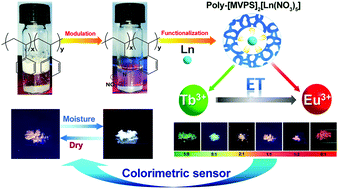Tunable luminescence of lanthanide (Ln = Sm, Eu, Tb) hydrophilic ionic polymers based on poly(N-methyl-4-vinylpyridinium-co-styrene) cations†
Abstract
Hydrophilic luminescent lanthanide polymers poly-[MVPS]2[Ln(NO3)5] (Ln = Sm (P1), Eu (P2), Tb (P3)) were designed and characterized. Benefiting from the methylation process of poly(4-vinylpyridinium-co-styrene) (PVPS), we switch the hydrophobicity of PVPS and further functionalize it by incorporating lanthanide luminophores into the chelate anion part to construct stable ionic polymer networks (P1–P3) by means of the anion–cation cooperative Coulombic interactions. These lanthanide polymers exhibit characteristic yellow, red and green emissions respectively which originate from the lanthanides Sm3+, Eu3+ and Tb3+. Furthermore, the chromatic colours of poly-[MVPS]2[Tb(NO3)5]/poly-[MVPS]2[Eu(NO3)5] (P3/P2) are readily modulated over a wide spectral emission from red over yellow to green. The energy transfer mechanism from the donor Tb3+ to the acceptor Eu3+ in the mixtures is further demonstrated. Interestingly, the straightforward reversible colorimetric water-responsive properties presented here offer a rapid approach to the broad-spectral colour tuning of water sensor materials. Therefore, these lanthanide-containing ionic polymers can be predicted to be utilized as promising candidates of reversible colorimetric components in the fabrication of UV-pumped sensors for water.


 Please wait while we load your content...
Please wait while we load your content...